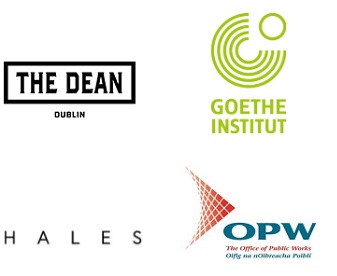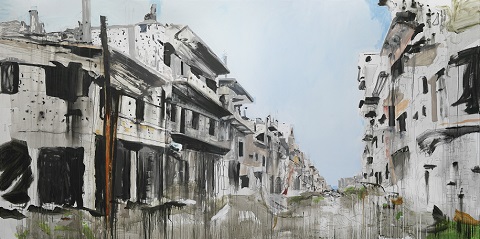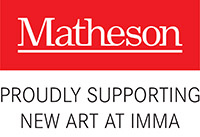Opening on 10 August 2018, IMMA is delighted to present Sunset, Sunrise, a major retrospective of the work of prominent Iranian artist Monir Shahroudy Farmanfarmaian (b.1924, Qazvin, Iran). Now in her mid-nineties, this exhibition marks the first solo exhibition of Farmanfarmaian’s work in Ireland. Sunset, Sunrise offers a rare opportunity to rediscover the breathtakingly kaleidoscopic nature of Farmanfarmaian’s 1970s sculpture and to encounter drawings, jewellery and previous unseen embroidery and collages from the 1980s, alongside new pen and ink drawings, fresh from the artist’s studio in Iran. Over 70 works are on display, encompassing a multitude of artistic genres which inform the artist’s practice
Sunset Sunrise will be opened on the evening of Thursday 9 August by noted international curator Hans Ulrich Obrist, Co-Director of the Serpentine Galleries, London, a friend and long-time supporter of Farmanfarmaian.
On showing her work in Ireland Monir Shahroudy Farmanfarmaian said “The Irish and the Iranians share a love of poetry in their cultures. My poetry is in my art, and I am honoured to share it in this IMMA exhibition”.
Born in Qazvin, Iran in 1924, Farmanfarmaian’s distinguished career has spanned more than six decades. The artist attended the Fine Arts College of Tehran before becoming one of the first Iranian students to study in the United States after World War II. Between 1945 and 1957 she was engulfed in this epicentre of the modern art world, and it was here that she worked alongside many iconic contemporary American artists including Jackson Pollock, Frank Stella, Louise Nevelson and Andy Warhol, all of whom had an influence on her work. In 1957 she returned to Iran. She was abroad when the Islamic, or Iranian Revolution of 1979 broke out, effectively making her an exile until 1992. Returning to Iran in 2004 she is now firmly re-established in her native country and is considered one of the most important Iranian artists working today with the opening of The Monir Museum in 2017 – the first Museum in Iran dedicated to a female artist.
Rachel Thomas, Senior Curator: Head of Exhibitions at IMMA first discovered Farmanfarmaian’s work when she was researching for the popular IMMA exhibition As Above, So Below and goes on to say; “Monir’s pioneering approach as an Iranian artist, fuses traditional skills with contemporary sensibilities to create a truly global and timeless practice, and one that deserved a significant international retrospective. I am particularly pleased that IMMA was able to originate this new framing of Monir Shahroudy Farmanfarmaian here in Dublin, and that we will tour the exhibition to our partners in Sharjah next year”.
Encapsulating histories of both East and West, Sunset, Sunrise reflects a life lived between two cultures, as the artist’s early involvement with graphic design and experimental modern abstraction in New York City gave way to a period of intense research into traditional craftsmanship and folk art in Iran’s more remote regions. Western avant-garde principles were maintained by the artist while she delved into Persian mysticism and simultaneously evoked the socio-political Islamic landscape as well as the easily recognisable geometry of Iran’s artistic and architectural heritage. Embedded in this collision of cultures, Farmanfarmaian navigated a path to her own distinct form of rich geometric abstraction.
While Farmanfarmaian’s practice has historically been overlooked in certain contemporary art discourses, her work has proven prescient and influential for many artists working today. The exhibition at IMMA establishes Farmanfarmaian as one of the great pioneering female artists, set alongside such 20th-century innovators such as Etel Adnan, Carol Rama and Hilma af Klint, all of whom have been rediscovered for their vital contributions to the development of contemporary art, and who have been represented within group and solo exhibitions at IMMA over the last three years.
Sunset, Sunrise investigates the abundance and mystery of nature, the universe and our place within it. Presenting over 70 works the exhibition includes key works Sunrise (2015) and Sunset (2015), both created using mirror and reverse-glass painting on plaster and wood. These pieces, from which the exhibition takes its title, exemplify Farmanfarmaian’s ability to merge traditional Persian techniques with contemporary abstraction. Other works, such as Untitled (2012) and Untitled 4 (2016), are shown here for the first time. These works incorporate highly reflective materials such as mirror and glitter on paper which are in line with the artist’s use of luxurious textures such as pearls, crystals, beads and gold leaf within her wider practice. Also showing is the intimate documentary film, Monir, 2015, chronicling the life and work of the artist, directed by Bahman Kiarostami and produced by Leyla Fakhr.
Sunset, Sunrise is co-curated by Rachel Thomas (Senior Curator: Head of Exhibitions, IMMA) and Hoor Al Qasimi (Director, Sharjah Art Foundation). The exhibition is organised by IMMA in collaboration with Sharjah Art Foundation, United Arab Emirates. The exhibition will travel to Sharjah Art Foundation in 2019.
A fully illustrated publication accompanies the exhibition, focusing on architecture, poetry and a fresh re-evaluation of Monir Shahroudy Farmanfarmaian’s practice. Included in the publication are Farmanfarmaian’s favourite poems joined by newly commissioned texts by Rahel Aima, Dr Tina Kinsella, Caoimhín Mac Giolla Léith, Murtaza Vali, Rachel Thomas and Hoor Al Qasimi, as well as extracts from Hans Ulrich Obrist’s previously published interviews. The publication is co-published by IMMA and Sharjah Art Foundation.
A new Limited Edition print of the work of Monir Shahroudy Farmanfarmaian, titled Sunrise, will be available to purchase at the IMMA Shop.
– Ends –
For more information and images please contact Monica Cullinane e: [email protected] t: + 353 1 612 9922.
Editors Notes
About the Artist
Born in Qazvin, Iran in 1924, Monir’s distinguished career has spanned more than five six decades. The artist attended the Fine Arts College of Tehran before becoming one of the first Iranian students to study in the United States after World War II. She graduated from Parsons School of Design in 1949 and then became a Member of the New York Art Students’ League (1950-53). Engulfed in the epicentre of the modern art world, it was here that she worked alongside many iconic contemporary American artists including Jackson Pollock, Frank Stella, Louise Nevelson and Andy Warhol, all who had an influence on her work.
Monir has exhibited extensively in international institutions in Iran, North America and Europe. Recent solo exhibitions include a traveling retrospective, Monir Shahroudy Farmanfarmaian: Infinite Possibilities at the Fundação de Serralves, Porto, Portugal (2014), and to Solomon R. Guggenheim Museum, New York, NY,2015; Lineages, Savannah College of Art and Design Museum (2017); Monir Farmanfarmaian: Infinite Geometry, The Third Line, Dubai (2016); Jef Geys/Monir Farmanfarmaian, WIELS, Brussels (2013); Convertibles and Polygons, Museum of Fine Arts, Houston, TX, USA (2012); Geometry of Hope, Leighton House Museum, London, UK (2008); Monir Shahroudy Farmanfarmaian: Mirror Mosaics, Victoria & Albert Museum, London, UK (2007). Her work has been included in several prominent group exhibitions including DECOR, Villa Empain, Boghossian Foundation, Brussels, Belgium (2016); Sharjah Biennial 11 (2015); Seeing Through Light, The Guggenheim Abu Dhabi Collection Opening exhibition, Manarat al Saadiyat, Abu Dhabi, UAE (2015); Iran Modern at Asia Art Society, New York, USA (2013); Trade Routes, Hauser & Wirth, London, UK (2013); Contemporary Iranian Art from the Permanent Collection, Metropolitan Museum of Art, New York (2012); The Future of Tradition, Haus der Kunst, Munich, Germany (2010).
She has participated in four editions of the Venice Biennale, where she was awarded the Gold Medal in 1958, 1964 and 1966. She also participated in the 6th Asia Pacific Triennial at Queensland Art Gallery, Australia, and at Liquid City, the 2nd Brugge Triennial in Brugge, Belgium (2018). Monir’s work is housed in several major public collections including the Museum of Contemporary Art, Chicago; The Solomon R. Guggenheim Museum, New York; The Metropolitan Museum, New York; the Victoria and Albert Museum’s Jameel Collection, London; The Queensland Art Gallery, Australia; The Tehran Museum of Contemporary Art, Iran; Swisscorp Bank, Geneva, Switzerland; The Sharjah Art Foundation; and the School of Law at Columbia University, America. Monir lives and works in Tehran.
Associated Talks and Events
Talk & Exhibition Preview / Aziz Isham – Monir Shahroudy Farmanfarmaian, Sunset, Sunrise
Thursday 9 August / 6.30pm / Lecture Room / Booking advised
In conjunction with the exhibition preview of Sunset, Sunrise producer, journalist and activist Aziz Isham, grandson of Monir Shahroudy Farmanfarmaian, presents an introduction to the rich cultural and artistic diversity of Farmanfarmaian’s practice over a period of 40 years. Isham’s lecture provides a personal perspective on some of the most defining movements that have shaped and influenced his grandmother’s life and work. This talk is followed by the official launch.
Curators Lunchtime Talk Series
Friday 21 September / 1.15pm – 2.00pm / Drop In
Meeting Point – IMMA Main Reception
Rachael Gilbourne, Exhibitions, IMMA, presents an insightful walkthrough of the exhibition Sunset, Sunrise.
Artist Response / Roxana Manouchehri / Monir Shahroudy Farmanfarmaian
Friday 5 October / 1.00pm / Main Galleries, West Wing / Booking advised
Artist Roxana Manouchehri reflects on the craft, skills and artistic traditions of her native country Iran, in the context of the exhibition Sunset, Sunrise. Manouchehri’s response explores the merging of traditional Persian techniques with contemporary abstraction that Monir Shahroudy Farmanfarmaian not only pioneered but continues to influence on a subsequent generation of artists. Taking the form of an exhibition walk-through, this talk looks at geometrical patterns and its roots in mathematics, repetition and spirituality, derived from 15th century Persian architecture and decorative mirror work.
Tickets will be available from the IMMA Talks section of our website. All talks are free but ticketed unless otherwise stated.







_logo_(250x177).jpg)